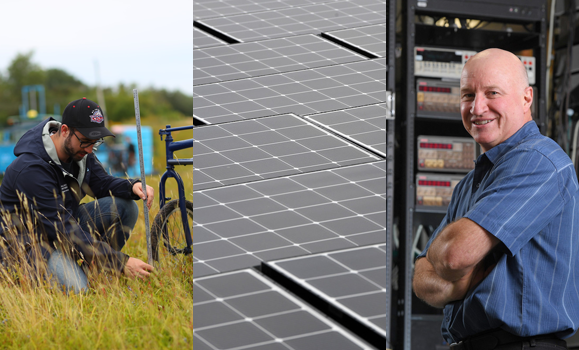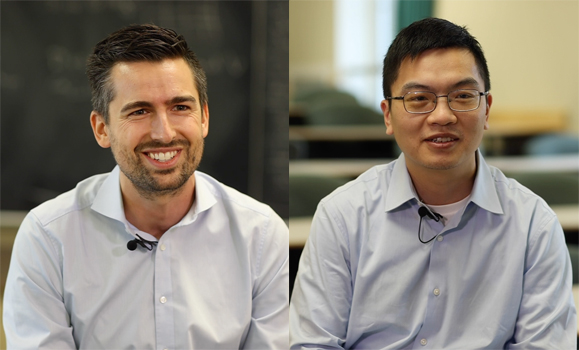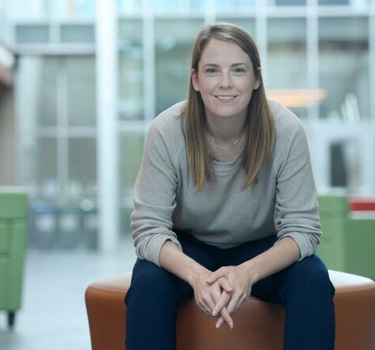
Left to right: Research on the Agricultural Campus, solar panels on Sexton Campus, and Jeff Dahn, the NSERC/Tesla Industrial Research Chair and Canada Research Chair in Battery and Fuel Cell Materials.
Our world is changing — and research is changing with it. The Big Picture, a long-form Dal News series, provides an in-depth look at specific areas of research with global implications.
Climate change is one of the world’s most pressing problems. Global temperatures are rising, the ocean is warming and becoming increasingly acidic, glaciers are in retreat, sea levels are rising and extreme weather events are becoming more frequent. All these developments point to a need for more responsible stewardship of the planet. Research can help lead the way, offering innovative solutions to the damage being done to our natural environment.
Dalhousie has grounded its strategic research direction in the United Nations’s Sustainable Development Goals, which cements the university’s commitment to conducting research that creates innovative, powerful change in the world.
“Recent technological innovations have driven down the cost of cleaner, resource-efficient technologies, making them competitive on price and performance,” says Alice Aiken, Dalhousie’s vice president research and innovation. “At the same time, clean technology has become an intrinsic part of a sustainable economy. Our researchers are, quite simply, creating smarter solutions for today’s economy – and tomorrow’s world.”
Power players
Researchers at Dal are investigating batteries as power sources for electric vehicles and are playing a key role in significantly increasing the life of batteries.
Jeff Dahn, the NSERC/Tesla Industrial Research Chair and Canada Research Chair in Battery and Fuel Cell Materials, has been at the forefront of battery research for the past four decades. His work can be found in lithium-ion rechargeable batteries used around the world in power tools, electric vehicles and other devices.
“We can’t just keep burning fossil fuels; we’re going to heat the planet to death,” says Dr. Dahn. “If you like the seashore, and you want to continue to have land that you currently see not be submerged, you have to do something about it.”
It was Dr. Dahn’s reputation that led to come north-and-east to Dalhousie and sign its first-ever university research partnership. In 2016, the leadi ng American electric vehicle and clean energy company began a five-year exclusive collaboration with the Dahn Lab, focused on increasing the lifetime, decreasing the cost, and improving the energy density of lithium-ion batteries.
ng American electric vehicle and clean energy company began a five-year exclusive collaboration with the Dahn Lab, focused on increasing the lifetime, decreasing the cost, and improving the energy density of lithium-ion batteries.
In January 2021, two new research chairs joined this exclusive partnership, which has been renewed until at least 2026.
Chongyin Yang is the Tesla Canada Research Chair and has been working for the past 12 years on materials and devices for energy conversion and storage. His research group is focusing on developing high-performance materials for advanced lithium-ion batteries, which includes sustainable electrode materials that contain no transition metals (like iron, copper, or titanium). The group will play a critical role in the Dalhousie-Tesla partnership that seeks lower-cost, longer-lifetime, and higher-energy battery technologies as the next generation energy storage solution for electric vehicles and sustainable green energy.
Michael Metzger, Dal's Herzberg-Dahn Chair, focuses his research on developing novel methods to study the performance and lifetime of advanced lithium-ion batteries, lithium metal batteries and desalination batteries. The goal is to create fundamental understanding that will help develop electrode materials and electrolytes for stationary and electric vehicle batteries.
Drs. Metzger and Yang shown above right.
Read more: Advanced battery scientists join exclusive Tesla partnership at Dal in research chair roles
 Mark Obrovac (shown left) in the Department of Chemistry has extensive industrial experience in the research, development, and manufacture of battery materials. Dr. Obrovac's lab develops next generation battery materials and innovative processes that enable the production of Li-ion battery materials at reduced cost, with less waste and greater sustainability. Despite their simplicity, these new processes also have the ability to make never- before possible designer materials that can improve battery performance while reducing cost.
Mark Obrovac (shown left) in the Department of Chemistry has extensive industrial experience in the research, development, and manufacture of battery materials. Dr. Obrovac's lab develops next generation battery materials and innovative processes that enable the production of Li-ion battery materials at reduced cost, with less waste and greater sustainability. Despite their simplicity, these new processes also have the ability to make never- before possible designer materials that can improve battery performance while reducing cost.
“I like to create technology that can be practically used to benefit society and the environment,” says Dr. Obrovac. “I am particularly fascinated by how extremely simple processes can create highly complex materials, especially where materials essentially make themselves. I believe that a better understanding of such processes can lead to many more high-performance materials that are affordable and sustainable for widespread application within the battery space and in other fields.”
Dr. Obrovac's research is funded by Novonix, which was spun out from Dr. Dahn’s lab. Led by Chris Burns (MSc’11, PhD’15), the goal of this company has been to bring state-of-the-art battery testing solutions from lab to market. Novonix’s current industry customers include Honda, Panasonic, Dyson, and Bosch (to name a few). Novonix also supplies materials to major battery manufacturers.
Novonix is in the process of scaling-up new materials technology developed in the Obrovac lab. The Obrovac-Novonix research partnership has recently been given a boost with a major NSERC Alliance funding award.
Read more: Battery breakthrough: Dal researcher receives $3.3M to revolutionize the way batteries are made
Meeting the world’s energy needs
Most renewable energies are intermittent: the sun rises and sets and is obscured by clouds, winds blow at varying speeds, while tides go in and out.
Dal’s researchers are focused on the research and development of energy storage technologies, either electrical or thermal, to bridge the gap between time of production and time of use and to properly integrate those systems into the electrical grid and buildings. The work they are doing is helping to reduce the demand for electricity production in peak periods and improving solar energy systems by storing energy for use when the sun is not shining.
Ghada Koleilat (shown right), Canada Research Chair in Advanced Materials for Energy Application, is creating more efficient solar cells using a rational molecular design based on advanced material innovations. She and her research team are creating efficient solar cell designs based on the scalable deposition of highly oriented crystal structures. In addition, they are hoping to engineer mechanically compliant solar converters for wearable electronics and other applications.
Read more:
Delivering a safe, nutritious, and abundant food supply
 The impact of clean research in agriculture and food technologies is far-reaching. Dal’s scientists are solving real-world problems with leading-edge technology, in partnership with a wide variety of industries, and producing significant benefits to the people of Atlantic Canada and beyond.
The impact of clean research in agriculture and food technologies is far-reaching. Dal’s scientists are solving real-world problems with leading-edge technology, in partnership with a wide variety of industries, and producing significant benefits to the people of Atlantic Canada and beyond.
The Mechanized Systems and Precision Agricultural Research Program, located within the Faculty of Agriculture, is aiming to automate the existing agricultural machinery for wild blueberries to reduce usage to agricultural inputs, improve land stewardship, increase profitability of the blueberry industry and enhance the sustainability of rural life in Atlantic Canada.
“Incorporating artificial intelligence into agriculture has major advantages to improve efficiencies and increase agricultural sustainability,” says Travis Esau, associate professor in the Faculty of Agriculture. “Maintaining industry sustainability, building food security, reducing the overall carbon footprint of the producer, training high-quality personnel and teaching students to solve real-world problems are all outcomes of research partnerships.”
Select projects this research group are currently working on involve:
· Developing a working prototype for implementation of spot application of the herbicide dichlobenil at a commercial field scale. Once tested, they will also be looking at the economic benefit of the newly developed technology for use in the wild blueberry industry.
· Creating a fully automated harvester using novel, automated and integrated precision agriculture technologies. This project, in partnership with Doug Bragg Enterprises, strives to develop a cost-effective sensing and control system to automate the commercial blueberry harvester to increase harvestable yield and quality, and decrease operator stress.
· Application of satellite-based vegetation indices for precise crop management
· Investigating cutting-edge technologies used in agriculture and dykeland management, including unmanned aerial vehicles, modern surveying and land forming equipment, remote sensing technologies and precision agriculture.
“We’re continually inspired by amazing industry partners, students eager to learn about new technologies and seeing the commercial benefit of the research,” says Dr. Esau.
Testing the water
Water is one of the primary elements responsible for life on earth. We drink it, cook with it, and use it to keep ourselves clean. Most of us turn on our tap without giving it a second thought, but ensuring that everyone has reliable access to a safe and clean water source is vital.
Dal’s researchers are addressing real challenges faced by the water community and are providing a platform for the development and appropriate application of water technology; water quality analysis and advancement, and outreach through knowledge transfer to communities and industry partners. During the COVID-19 pandemic, some of the researchers in this area pivoted to help address the immediate epidemiological needs that it presented.
water quality analysis and advancement, and outreach through knowledge transfer to communities and industry partners. During the COVID-19 pandemic, some of the researchers in this area pivoted to help address the immediate epidemiological needs that it presented.
Amina Stoddart (shown right), Graham Gagnon, Rob Jamieson, , , and Emalie Hayes are leading a unique initiative intended to develop a wastewater surveillance approach for SARS-CoV-2 throughout Nova Scotia that is helping support public health decision making.
Read more: Project to detect COVID-19 early through wastewater expands across Nova Scotia
These researchers are collaborating with co-investigators at Halifax Water, Acadia University, Cape Breton University and St. Francis Xavier University. A test developed by Dr. Gagnon and his team and LuminUltra Technologies will be used to collect samples at sites in the Halifax Regional Municipality, Wolfville, Antigonish and the Cape Breton Regional Municipality.
Because of this important work, the research team has been involved in many national conversations that are being led by the Public Health Agency of Canada.
Dal’s clean research future
A Clean Research Summit will be hosted on Monday, June 28, 2021 for members of the Dalhousie research community to come together to strategize how to best position ourselves to ensure our readiness for the many large-scale funding opportunities that are on the horizon.
Please save the date and plan on joining us with your ideas about how to elevate Dalhousie’s clean research efforts to the next level! RSVP to Maureen Keough at Maureen.keough@dal.ca
Interested in learning even more about clean research happening at Dalhousie? Visit dal.ca/cleanresearch.
Previously in this series:
The Big Picture: Vaccines — How they work, and why we still need them
The Big Picture: The looming threat of rising sea levels — and what we can do about it
